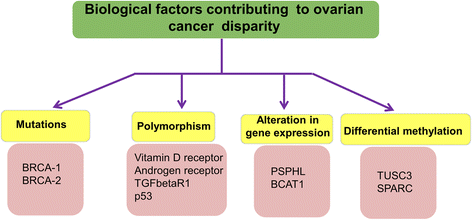Racial health disparities in ovarian cancer: not just black and white
- PMID: 28931403
- PMCID: PMC5607508
- DOI: 10.1186/s13048-017-0355-y
Racial health disparities in ovarian cancer: not just black and white
Abstract
Ovarian cancer (OC) is the most lethal gynecological malignancy, which disproportionately affects African American (AA) women. Lack of awareness and socioeconomic factors are considered important players in OC racial health disparity, while at the same time, some recent studies have brought focus on the genetic basis of disparity as well. Differential polymorphisms, mutations and expressions of genes have been reported in OC patients of diverse racial and ethnic backgrounds. Combined, it appears that neither genetic nor the socioeconomic factors alone might explain the observed racially disparate health outcomes among OC patients. Rather, a more logical explanation would be the one that takes into consideration the combination and/or the interplay of these factors, perhaps even including some environmental ones. Hence, in this article, we attempt to review the available information on OC racial health disparity, and provide an overview of socioeconomic, environmental and genetic factors, as well as the epigenetic changes that can act as a liaison between the three. A better understanding of these underlying causes will help further research on effective cancer management among diverse patient population and ultimately narrow health disparity gaps.
Keywords: Epigenetic; Ovarian cancer; Racial health disparity; Socioeconomic.
Conflict of interest statement
Authors’ information
SKS, AA, SS, RPR and APS are part of Health Disparities in Cancer Research Program at the University of South Alabama’s Mitchell Cancer Institute.
Ethics approval and consent to participate
Not Applicable.
Consent for publication
All authors agree to the submission of this article for publication.
Competing interests
APS and SS are co-founders and serve on executive management board of Tatva Biosciences LLC, a small business involved in the development of tools and models for cancer health disparity research among other things. SKS serves as the Director of Cell Biology and Genetics at Tatva Biosciences LLC.
Publisher’s Note
Springer Nature remains neutral with regard to jurisdictional claims in published maps and institutional affiliations.
Figures


Similar articles
-
A review of racial disparities in ovarian cancer and clinical trials.Curr Opin Obstet Gynecol. 2024 Feb 1;36(1):23-27. doi: 10.1097/GCO.0000000000000923. Epub 2023 Oct 19. Curr Opin Obstet Gynecol. 2024. PMID: 38170549 Review.
-
A review of the effects of healthcare disparities on the experience and survival of ovarian cancer patients of different racial and ethnic backgrounds.J Cancer Metastasis Treat. 2019;5:13. doi: 10.20517/2394-4722.2018.25. Epub 2019 Feb 27. J Cancer Metastasis Treat. 2019. PMID: 31236478 Free PMC article.
-
Racial and ethnic differences in reproductive potential across the life cycle.Fertil Steril. 2010 Feb;93(3):681-90. doi: 10.1016/j.fertnstert.2009.10.047. Epub 2009 Nov 25. Fertil Steril. 2010. PMID: 19939362 Review.
-
Understanding current racial/ethnic disparities in colorectal cancer screening in the United States: the contribution of socioeconomic status and access to care.Am J Prev Med. 2014 Mar;46(3):228-36. doi: 10.1016/j.amepre.2013.10.023. Am J Prev Med. 2014. PMID: 24512861
-
Role of epigenetics in cancer health disparities.Methods Mol Biol. 2012;863:395-410. doi: 10.1007/978-1-61779-612-8_25. Methods Mol Biol. 2012. PMID: 22359308 Review.
Cited by
-
Regional Disparities in Ovarian Cancer in the United States.Cancer Health Disparities. 2019;3:e1-e12. Epub 2019 Aug 19. Cancer Health Disparities. 2019. PMID: 33842845 Free PMC article.
-
The Destruction Of Laser-Induced Phase-Transition Nanoparticles Triggered By Low-Intensity Ultrasound: An Innovative Modality To Enhance The Immunological Treatment Of Ovarian Cancer Cells.Int J Nanomedicine. 2019 Dec 2;14:9377-9393. doi: 10.2147/IJN.S208404. eCollection 2019. Int J Nanomedicine. 2019. PMID: 31819438 Free PMC article.
-
Healthcare Disparities in Gynecologic Oncology.Adv Oncol. 2022 May;2(1):119-128. doi: 10.1016/j.yao.2022.02.003. Epub 2022 May 4. Adv Oncol. 2022. PMID: 35669851 Free PMC article. No abstract available.
-
Characteristics of African American women at high-risk for ovarian cancer in the southeast: Results from a Gynecologic Cancer Risk Assessment Clinic.Gynecol Oncol. 2018 May;149(2):337-340. doi: 10.1016/j.ygyno.2018.02.014. Epub 2018 Mar 2. Gynecol Oncol. 2018. PMID: 29486991 Free PMC article.
-
Clinicopathologic significance and race-specific prognostic association of MYB overexpression in ovarian cancer.Sci Rep. 2021 Jun 18;11(1):12901. doi: 10.1038/s41598-021-92352-3. Sci Rep. 2021. PMID: 34145334 Free PMC article.
References
Publication types
MeSH terms
Grants and funding
LinkOut - more resources
Full Text Sources
Other Literature Sources
Medical

